Click on images to enlarge

infestation (Photo: Sheldon Navie)
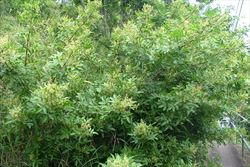
habit in flower (Photo: Sheldon Navie)
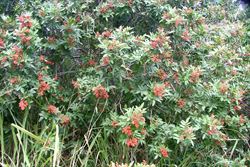
habit in fruit (Photo: Sheldon Navie)
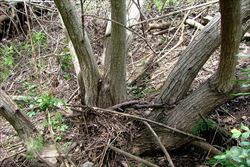
multiple trunks of an older tree (Photo: Sheldon Navie)
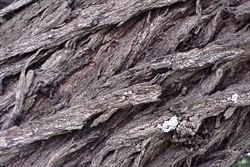
close-up of bark on trunk of older tree (Photo: Sheldon Navie)
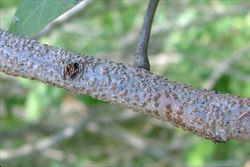
younger branch with raised spots (Photo: Sheldon Navie)
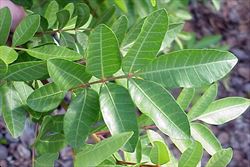
once-compound leaf with several leaflets (Photo: Sheldon Navie)
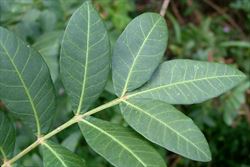
close-up of relatively broad leaflets (Photo: Sheldon Navie)
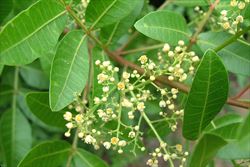
male flowers (Photo: Sheldon Navie)
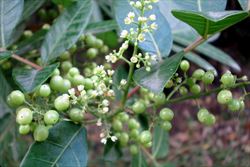
female flowers and immature fruit (Photo: Sheldon Navie)
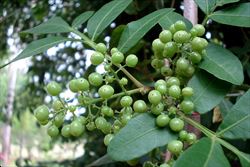
close-up of immature fruit (Photo: Sheldon Navie)
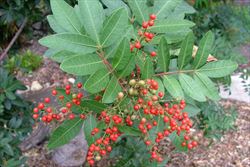
leaves and clusters of mature fruit (Photo: Sheldon Navie)
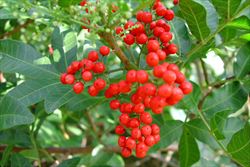
close-up of mature fruit (Photo: Sheldon Navie)
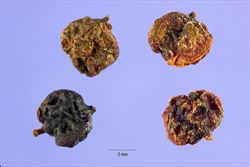
close-up of seeds (Photo: Steve Hurst at USDA PLANTS Database)
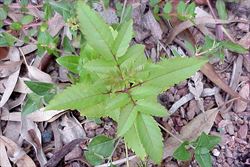
seedling with toothed leaflets (Photo: Sheldon Navie)
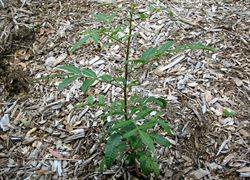
root sucker (Photo: Sheldon Navie)
Scientific Name
Schinus terebinthifolius Raddi
Synonyms
Schinus terebinthifolia Raddi
Family
Anacardiaceae
Common Names
Brazilian holly, Brazilian pepper, Brazilian pepper tree, Brazilian peppertree, broad leaf pepper tree, broadleaf pepper tree, broad-leaved pepper tree, broadleaved pepper tree, Christmas berry, Christmas berry tree, Christmas berrytree, Florida holly, Japanese pepper, pepperina, schinus, South American pepper
Origin
Native to tropical South America (i.e. Brazil, Argentina and Uruguay).
Cultivation
A commonly cultivated garden plant (i.e. ornamental) in the coastal regions of Australia.
Naturalised Distribution
A widespread species that has mainly become naturalised along the eastern and western coasts of Australia. It is most common in south-eastern Queensland and north-eastern New South Wales. Less common in the other coastal and sub-coastal regions of these states and along the western coast of Western Australia. Also recorded from the Northern Territory and on Norfolk Island.
Widely cultivated throughout the world and also naturalised in southern Europe (e.g. Malta), Africa (e.g. South Africa), tropical Asia, New Zealand, southern USA (e.g. Florida, Arizona, Texas and California), the Caribbean (e.g. the Bahamas, Puerto Rico and the US Virgin Islands), Oceania (e.g. Guam, New Caledonia, Hawaii) and the Mascarenes (e.g. La Réunion).
Habitat
A weed of sub-tropical, tropical and warmer temperate regions, particularly in areas near habitation. It is found along waterways and roadsides, in urban bushland, open woodlands, disturbed sites, waste areas and coastal wetlands.
Habit
A large tree with many arching or spreading branches and sometimes also multiple trunks. It usually grows 3-7 m tall and up to 10 m wide, but it can reach up to 16 m in height.
Distinguishing Features
- a large tree with spreading branches and compound leaves.
- its leaves have 5-9 leaflets, and these leaflets are stalkless.
- separate male and female flowers are borne on different plants.
- these flowers are inconspicuous and borne in densely branched clusters at the tips of the branches and in the leaf forks.
- its small glossy 'berries' (about 6 mm across) and turn bright red in colour when ripe.
Stems and Leaves
The younger branches are covered with small whitish coloured spots (i.e. lenticels) and its new stems are softly hairy (i.e. pubescent) or sparsely hairy (i.e. puberulent). The bark of older stems is dark brown or blackish in colour, very rough and deeply ridged.
The compound (i.e. pinnate) leaves (8-17 cm long) are alternately arranged along the stems and usually have 5-9 oval (i.e. elliptic), egg-shaped (i.e. ovate), or slightly elongated leaflets. The leaf stalk (i.e. petiole) is 20-30 mm long with a swelling at the base where it joins to the stem. The leaflets (15-80 mm long and 10-35 mm wide) are arranged in pairs, but there is a single leaflet at the tip (i.e. the leaves are imparipinnate). They are attached almost directly to the main leaf axis (i.e. they are sub-sessile) and have dark green upper surfaces and paler undersides. These leaflets are shiny, hairless (i.e. glabrous), and have entire or slightly toothed (i.e. serrulate) margins. Leaflets with toothed margins are generally found on seedlings, young plants, or suckers while mature plants generally have leaflets with entire margins.
Flowers and Fruit
Separate male and female (i.e. unisexual) flowers are borne on different plants (i.e. this species is dioecious). These flowers are borne in densely branched clusters (2-12.5 cm long) at the tips of the branches and in the upper leaf forks (i.e. in terminal or axillary panicles). Individual flowers are small, inconspicuous, and borne on stalks (i.e. pedicels) about 2 mm long. The male and female flowers both have five tiny green sepals and five small whitish-coloured petals (about 2 mm long). The male flowers also possess ten tiny yellow stamens while the female flowers have an ovary topped with three short styles. Flowering occurs throughout the year, but mostly during spring and autumn.
The fruit look like small fleshy 'berries' but they have a single, hard, light brown coloured seed in the centre (i.e. they are actually drupes). These fruit (4-6.5 mm across) are rounded (i.e. globular), glossy in appearance, and turn bright red in colour when ripe. When the fruit is fully mature its skin becomes fragile and flakes apart. Fruit are present mainly during winter.
Reproduction and Dispersal
This plant reproduces by seed and also produces suckers from damaged roots or from cut stumps.
Seeds are mostly dispersed by birds that eat the fruit.
Environmental Impact
Broad-leaved pepper tree (Schinus terebinthifolius) is regarded as a significant environmental weed in Queensland and New South Wales and as a potentially significant environmental weed in Western Australia. It is also regarded as a "sleeper weed" in other parts of Australia and was recenly listed as a priority environmental weed in two Natural Resource Management regions.
Broad-leaved pepper tree (Schinus terebinthifolius) is also listed in the Global Invasive Species Database, and has been selected among the top 100 of the world's worst invasive alien species.
Legislation
This species is declared under legislation in the following states and territories:
- New South Wales: Class 3 - a regionally controlled weed. The relevant local control authority must be promptly notified of the presence of this weed and it must be fully and continuously suppressed and destroyed (in the Ballina, Bellingen, Byron, Clarence Valley, Coffs Harbour, Gloucester, Great Lakes, Greater Taree, Kempsey, Kyogle, Lismore, Nambucca, Port Macquarie-Hastings, Richmond Valley and Tweed local authority areas).
- Queensland: Class 3 - this species is primarily an environmental weed and a pest control notice may be issued for land that is, or is adjacent to, an environmentally significant area (throughout the entire state). It is also illegal to sell a declared plant or its seed in this state.
- Western Australia: Unassessed - this species is declared in other states or territories and is prohibited until assessed via a weed risk assessment (throughout the entire state).
Management
For information on the management of this species see the following resources:
- the Biosecurity Queensland Fact Sheet on this species, which is available online at http://www.dpi.qld.gov.au.
- the New South Wales Department of Primary Industries Agfact on this species, which is available online at http://www.dpi.nsw.gov.au.
- the Environmental Weeds Action Network (EWAN) pamphlet on woody weeds, which is available online at http://members.iinet.net.au/~ewan/.
Similar Species
Broad-leaved pepper tree (Schinus terebinthifolius) may sometimes be confused with pepper tree (Schinus molle var. areira). These two species can be distinguished by the following differences:
- broad-leaved pepper tree (Schinus terebinthifolius) has spreading leaves with relatively broad leaflets (12-30 mm across).
- pepper tree (Schinus molle var. areira) has drooping (i.e. pendulous) leaves with very narrow leaflets (2-10 mm across).

